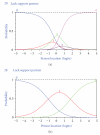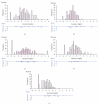Uncovering indicators of the international classification of functioning, disability, and health from the 39-item Parkinson's disease questionnaire
- PMID: 20976013
- PMCID: PMC2957468
- DOI: 10.4061/2010/984673
Uncovering indicators of the international classification of functioning, disability, and health from the 39-item Parkinson's disease questionnaire
Abstract
The 39-item Parkinson's disease questionnaire (PDQ-39) is the most widely used patient-reported rating scale in Parkinson's disease (PD). However, recent studies have questioned its validity and it is unclear what scores represent. This study explored the possibility of regrouping PDQ-39 items into scales representing the International Classification of Functioning, Disability, and Health (ICF) components of Body Functions and Structures (BF), Activities and Participation (AP), and Environmental (E) factors. An iterative process using Rasch analysis produced five new items sets, two each for the BF and AP components and one representing E. Four of these were found to represent clinically meaningful variables: Emotional Impairment (BF), Gross Motor Disability (AP), Fine Motor Disability (AP), and Socioattitudinal Environment (E) with acceptable reliability (0.73-0.96) and fit to the Rasch model (total item-trait chi-square, 8.28-33.2; P > .05). These new ICF-based scales offer a means to reanalyze PDQ-39 data from an ICF perspective and to study its health components using a widely available health status questionnaire for people with PD.
Figures


Similar articles
-
Psychometric properties of the International Classification of Functioning, Disability and Health set for spinal cord injury nursing based on Rasch analysis.Disabil Rehabil. 2018 Feb;40(3):338-345. doi: 10.1080/09638288.2016.1250169. Epub 2016 Dec 14. Disabil Rehabil. 2018. PMID: 27967253
-
The measurement of functioning using the International Classification of Functioning, Disability and Health: comparing qualifier ratings with existing health status instruments.Disabil Rehabil. 2019 Mar;41(5):541-548. doi: 10.1080/09638288.2017.1381186. Epub 2017 Oct 8. Disabil Rehabil. 2019. PMID: 28988490
-
Towards the development of clinical measures for spinal cord injury based on the International Classification of Functioning, Disability and Health with Rasch analyses.Arch Phys Med Rehabil. 2014 Sep;95(9):1685-94. doi: 10.1016/j.apmr.2014.05.006. Epub 2014 May 29. Arch Phys Med Rehabil. 2014. PMID: 24882520
-
Comparative content review of children's participation measures using the International Classification of Functioning, Disability and Health-Children and Youth.Arch Phys Med Rehabil. 2014 Jan;95(1):141-52. doi: 10.1016/j.apmr.2013.06.027. Epub 2013 Jul 12. Arch Phys Med Rehabil. 2014. PMID: 23851418 Review.
-
The relevance of the International Classification of Functioning, Disability and Health (ICF) in monitoring and evaluating Community-based Rehabilitation (CBR).Disabil Rehabil. 2014;36(10):826-37. doi: 10.3109/09638288.2013.821182. Epub 2013 Aug 14. Disabil Rehabil. 2014. PMID: 23944180 Review.
Cited by
-
Real world studies are essential for drug therapy in Parkinson's disease.Neural Regen Res. 2018 Sep;13(9):1544-1545. doi: 10.4103/1673-5374.237118. Neural Regen Res. 2018. PMID: 30127111 Free PMC article. No abstract available.
-
Method of successive dichotomizations: An improved method for estimating measures of latent variables from rating scale data.PLoS One. 2018 Oct 18;13(10):e0206106. doi: 10.1371/journal.pone.0206106. eCollection 2018. PLoS One. 2018. PMID: 30335832 Free PMC article.
-
Parkinson's Disease Multimodal Complex Treatment improves motor symptoms, depression and quality of life.J Neurol. 2020 Apr;267(4):954-965. doi: 10.1007/s00415-019-09657-7. Epub 2019 Dec 3. J Neurol. 2020. PMID: 31797086
References
-
- World Health Organization. ICF: International Classification of Functioning, Disability and Health. Geneva, Switzerland: World Health Organization; 2001.
-
- Cieza A, Brockow T, Ewert T, et al. Linking health-status measurements to the international classification of functioning, disability and health. Journal of Rehabilitation Medicine. 2002;34(5):205–210. - PubMed
-
- Prodinger B, Cieza A, Williams DA, et al. Measuring health in patients with fibromyalgia: content comparison of questionnaires based on the international classification of functioning, disability and health. Arthritis Care and Research. 2008;59(5):650–658. - PubMed
-
- Teixeira-Salmela LF, Neto MG, Magalhães LC, Lima RC, Faria CDCM. Content comparisons of stroke-specific quality of life based upon the international classification of functioning, disability, and health. Quality of Life Research. 2009;18(6):765–773. - PubMed
-
- Cieza A, Stucki G. Content comparison of health-related quality of life (HRQOL) instruments based on the International Classification of Functioning, Disability and Health (ICF) Quality of Life Research. 2005;14(5):1225–1237. - PubMed
LinkOut - more resources
Full Text Sources
Miscellaneous

